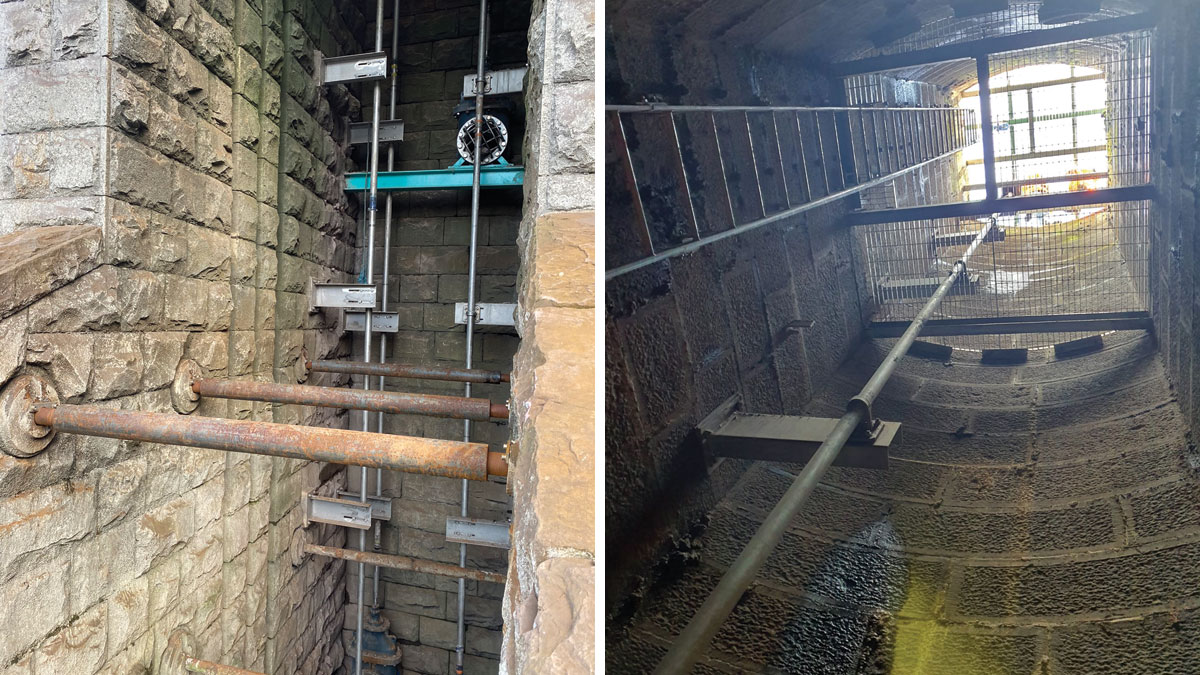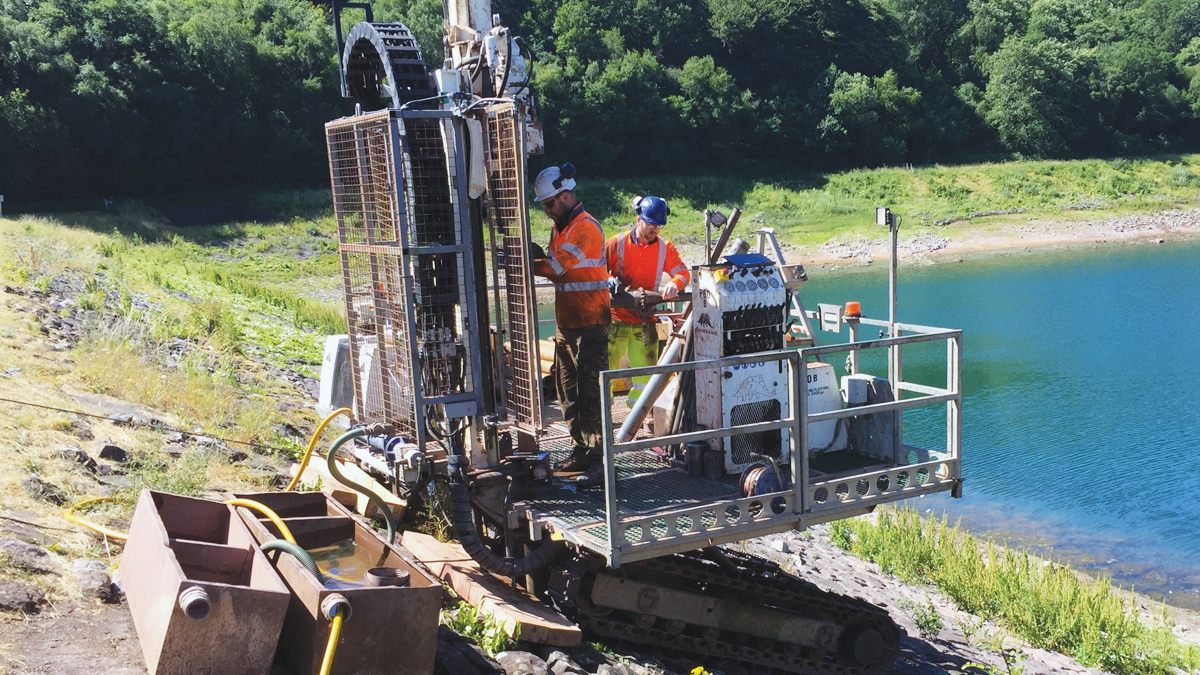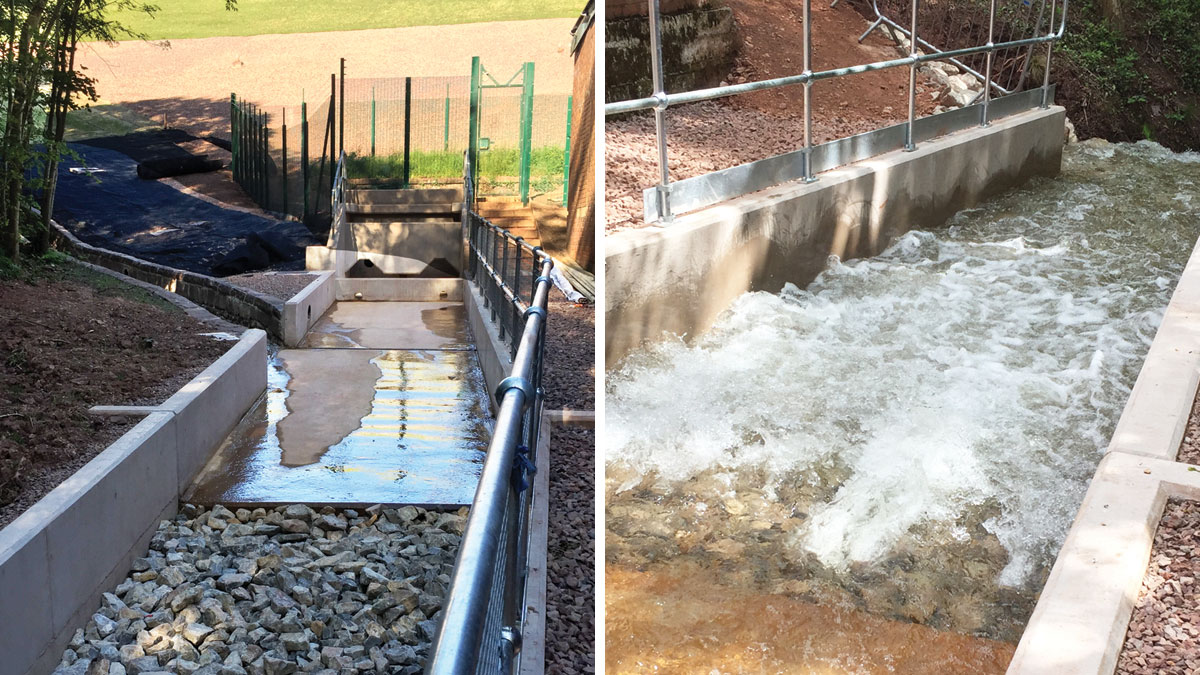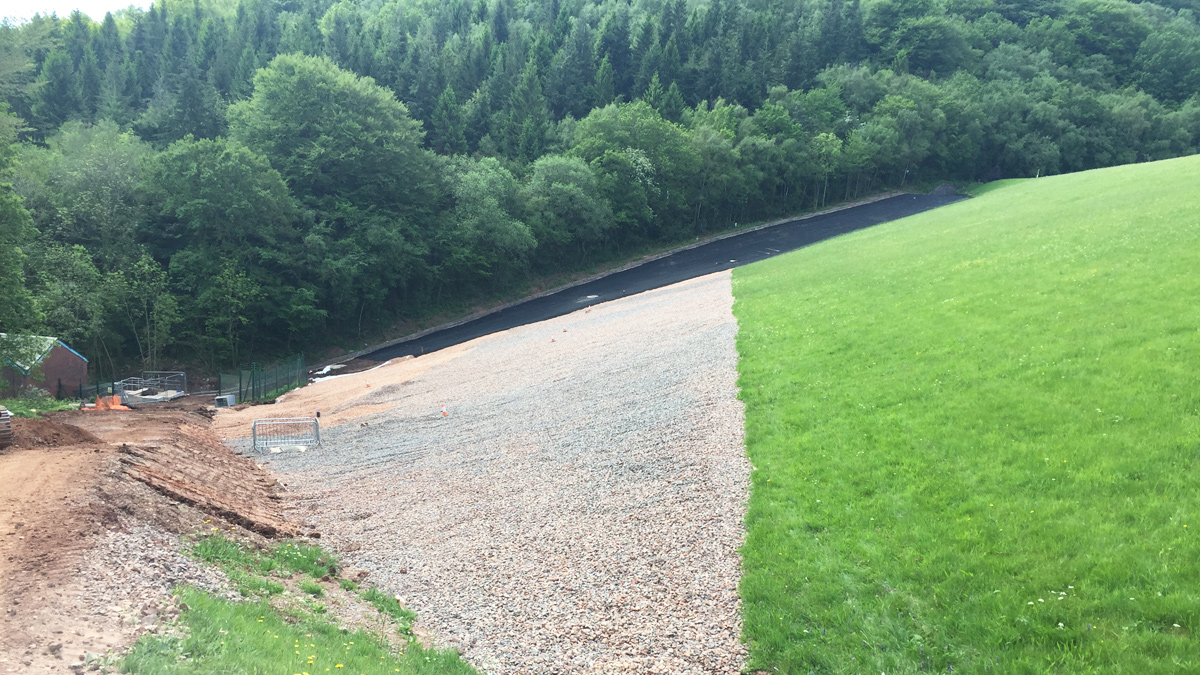Pant-Yr-Eos Reservoir (2022)

(left) Valve tower: scour valves, spindles and support brackets and (right) view of access and platforms within ‘dry’ tower - Courtesy of MMB
Pant-yr-Eos is a large raised reservoir situated approximately 2km east of Risca in the City of Newport, Monmouthshire. It is impounded by a 27m high, 280m long embankment dam with clay core, and has a storage capacity of approximately 600 Ml. The reservoir was completed in 1878 for provision of water supplies to Newport. To comply with matters of interest made under the Reservoirs Act 1975, improvement works at Pant-yr-Eos Reservoir were required to allow safe passage of the PMF, remedial works to the masonry spillway, improvements to the emergency scour system and a new filtered drainage blanket on the downstream embankment toe with associated instrumentation. Welsh Water contracted Mott MacDonald Bentley Ltd (MMB) as part of the Capital Delivery Alliance to undertake the design and construction of the works.
Ground investigation
MMB undertook a ground investigation with Geotechnical Engineering Limited as the ground investigation sub-contractor consisting of seven boreholes on the embankment (six on the lower part of the downstream face, one on the upstream face) and a series of cores within the spillway. The boreholes were installed using a P60 rotary slope-climbing drilling rig in order to aid a ground investigation, stability analysis and installation of piezometers.

P60 slope climbing rig – Courtesy of MMB
Drawdown study and remedial works
MMB completed a drawdown assessment and proposed various options to improve the draw-down capacity to meet the recently published UK guidance: ‘Guide to drawdown capacity for reservoir safety and emergency planning” (EA, 2017)’. The chosen solution to increase drawdown capacity converted the historic supply main into the emergency drawdown system with provisions to re-configure for supply if required in the future. The original emergency scour system was then discontinued enabling major environmental benefits in the prevention of large volume of silt removal. In collaboration with Welsh Water and the qualified civil engineer (QCE), the options considered to increase drawdown capacity were compared by considering the technical, system resilience, construction, cost, programme, environmental, carbon, operational, and maintenance risks and impacts. The works were undertaken with a partial drawdown of the reservoir utilising a suspended scaffold to replace the top three valves and underwater works using divers to replace the scour valve.
The drawdown study was undertaken in conjunction with an assessment of the slope stability of the upstream face under rapid drawdown conditions. The study aimed to provide rates that the reservoir can be drawdown safely during a routine operational drawdown and an emergency drawdown to help inform operational procedures and emergency planning.
Pant Yr Eos Reservoir Safety Improvements: Supply chain – key participants
- Client: Welsh Water
- Principal designer & contractor: Mott MacDonald Bentley
- Borehole installation on slopes: Geotechnical Engineering Ltd
- Pressure grouting of spillway: APA Concrete Repairs
- Diving works: Edwards Diving Services
- Over pumping installations: Pump Supplies Ltd
- Mechanical installations: Industrial Pipework Services
- Raw water sluice valves: Blackhall Ltd
Masonry spillway inspection and remedial works
MMB undertook an investigation of the condition of the existing masonry spillway taking into account the ‘Guidance for the Design and Maintenance of Stepped Masonry Spillways (Environment Agency October 2010)’, that identified the need for future investigation and works. The inspections and intrusive investigations confirmed loss of water within spillway through continued degradation. The following solution was adopted:
- Contact grouting beneath and adjacent to the spillway.
- Pressure pointing of masonry joints within spillway.
- Install vertical drains on the right-hand side of the spillway with weep holes through the channel wall.
- Install new drainage to the left-hand side of the spillway.

(left) Scour outlet chamber and embankment and (right) scour test upon completion – Courtesy of MMB
During the works, an opportunity arose to accelerate the programme by installing a concrete backing to the spillway left-hand side wall, instead of contact grouting. The grouting philosophy was modified to incorporate a combination of concrete backing and contact grouting. The works were implemented which enabled other works on the embankment to commence, saving circa 8-weeks on the construction programme by taking the contact grouting off the critical path.
The total amount of grout used to fill voids adjacent to the spillway was circa 27,800 litres. It has been noted that following the remedial works, flows within the channel are retained and no longer leak into and out of the spillway.
Drainage blanket
MMB installed a new drainage blanket covering the lower section of the down-stream slope that was known to be wet and have seepage emerging to the surface. The drainage blanket consisted of two layers of clean stone with a needle-punched nonwoven geotextile at the interface to the embankment. The new drainage blanket will reduce the risk of fines washout, manage seepage and the phreatic surface.
MMB imported approximately 7,500 tonnes of drainage material to construct the drain-age blanket, at a remote site with single tracked access, limited stockpile areas, and a local resident living adjacent to the reservoir that shared the only road onto the site. This challenge required the project team to manage delivery times, stockpile areas and coordinate with the local resident throughout the construction. New drainage with monitoring points were installed to collect flows from the drainage blanket. The drainage system was incorporated into the embankment toe arrangement, where the flows discharge into the new tail-bay.

Embankment drainage blanket and erosion protection – Courtesy of MMB
Other works on site
In order to address recommendations from previous studies, MMB designed and installed a suitable erosion protection reinforcement mesh to the right-hand mitre. The erosion protection mat and drainage blanket were designed and installed to have an overlapping interface to maximise the extent of the drainage blanket whilst ensuring all out-of-channel flows are captured by the erosion protection matting.
As part of the scheme, MMB undertook a full refurbishment of the valve tower with sub-contractors Industrial Pipework Solutions (IPS). All of the existing metalwork, including ladders and landings were removed, and replaced with additional landings to meet modern safety standards. The access requirements were discussed with Welsh Water’s dam safety team and the design subsequently optimised to reduce the time required to get a person out of the tower in an emergency, and simplify the escape route.
Completion
The works were undertaken under the supervision of the QCE and a Section 10(6) certificate was received upon completion in June 2019.




